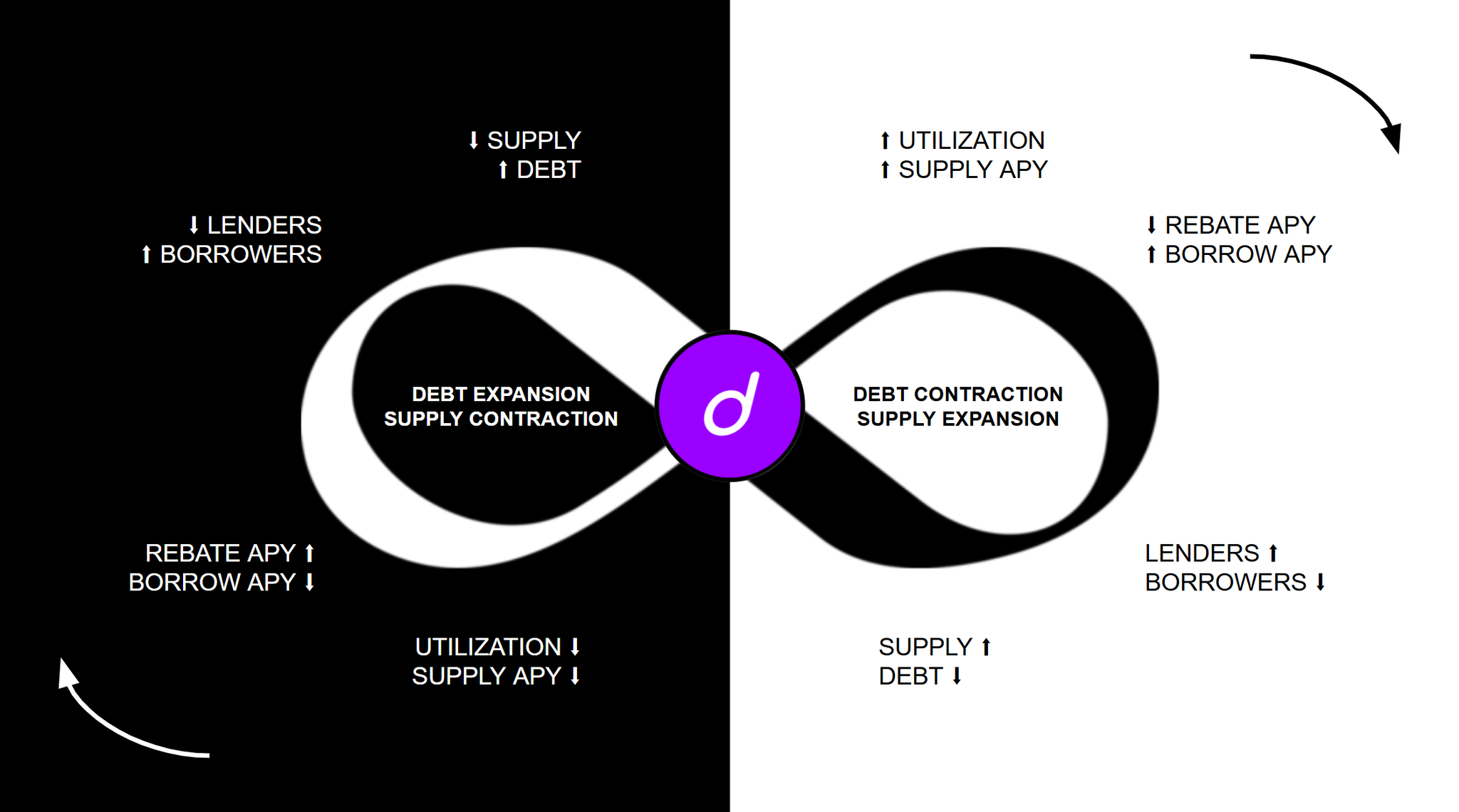
Overview
The dTRINITY economy is powered by natural credit expansion and contraction cycles of dSTABLE assets (e.g., dUSD). While this mirrors traditional credit cycles, it differs fundamentally in how interest rates influence growth.
In TradFi, central banks employ top-down monetary policies: low interest rates spur borrowing, expand the money supply, and stimulate growth, while high rates restrict credit to combat inflation. These levers are often politically influenced and artificially imposed.
In DeFi, interest rates emerge from decentralized market forces. Most lending protocols utilize interest rate models based on real-time supply and demand: low rates typically signal weak credit appetite in bear markets, while high rates reflect strong borrowing demand during bull runs.
dTRINITY’s growth strategy turns this dynamic into an advantage. By subsidizing borrowers, the protocol can lower net borrowing costs and maintain attractive yields for lenders—even during periods of low demand. This, in turn, stimulates protocol utilization and attracts more deposits, creating more subsidies and credit to fuel the flywheel. The result is a sustainable increase in dSTABLE money supplies and long-term TVL growth across all market cycles.
Key Metrics
Total Value Locked (TVL)
This is a commonly used metric to evaluate protocol growth in terms of supply-side liquidity. For dTRINITY, it is the sum of dSTABLE reserves plus lending deposits and collateral deposits on dLEND.
Total Debt Locked (TDL)
This is a new metric introduced by dTRINITY to measure dSTABLE debt expansion, i.e., demand-side credit. It is the sum of active loans on dLEND and partnered lending protocols that are denominated in dSTABLE assets.
TVL & TDL Dynamics
While TVL is a good indicator for supply-side liquidity, TDL is useful for tracking demand-side credit. Together, these two metrics offer a complete macro view of the dTRINITY economy.
TDL reflects active dSTABLE-denominated debt—credit that must eventually be repaid. As borrowers deleverage, this repayment increases dSTABLE reserves and circulating supplies, converting demand-side credit into supply-side liquidity. On the other hand, TVL only includes assets held directly within dTRINITY, excluding dSTABLE liquidity in DEXs and collateral securing dSTABLE debt in external money markets outside dLEND. As a result, credit expansion cycles may exhibit higher TDL than TVL growth. However, during credit contraction cycles, TDL naturally converts into TVL as debt gets repaid, no matter where the debt resides.
Flywheel Sequence for dUSD

Bull Market → Credit Expansion → Rising Rates
- Leverage Demand: Users supply collateral to borrow dUSD and earn subsidies (TVL and TDL increase)
- Rising Utilization: Borrowing increases total debt, pushing up protocol utilization
- Credit Velocity: Loopers and arbitrageurs swap dUSD, boosting DEX volume
- Reserve Contraction: Debt expansion increases arbitrage redemptions of dUSD (TVL decreases)
- Subsidy Dilution: More debt and fewer reserves dilute interest rebates
- Lending Rate: High utilization increases Supply APY for lenders
- Borrowing Rate: Lower subsidies raise Borrow APY for borrowers
- Trading Fees: Increased trading volume raises LP APY
- Credit Supply: High yields attract more dUSD issuance and deposits from lenders (TVL increases)
- Liquidity: Strong fee generation for LPs helps increase dUSD issuance and DEX liquidity (TVL increases)
Bear Market → Credit Contraction → Falling Rates
- Deleverage Demand: Borrowers repay dUSD debt to withdraw collateral (TVL and TDL decrease)
- Falling Utilization: Repayments reduce debt, decreasing protocol utilization
- Credit Velocity: Unloopers and arbitrageurs sustain dUSD trading volume
- Reserve Expansion: Debt repayment increases dUSD issuance (TVL increases)
- Subsidy Regeneration: Fewer borrowers and larger reserves boost subsidies
- Lending Rate: Lower utilization decreases Supply APY for lenders, though the protocol can offset this by providing lenders with extra rewards/emissions
- Borrowing Rate: Higher subsidies reduce Borrow APY for borrowers
- Trading Fees: Consistent volume helps sustain LP APY
- Credit Supply: Protocol rewards/emissions help retain lenders (less TVL outflow)
- Liquidity: Strong fee generation and rewards/emissions help retain LPs (less TVL outflow)
